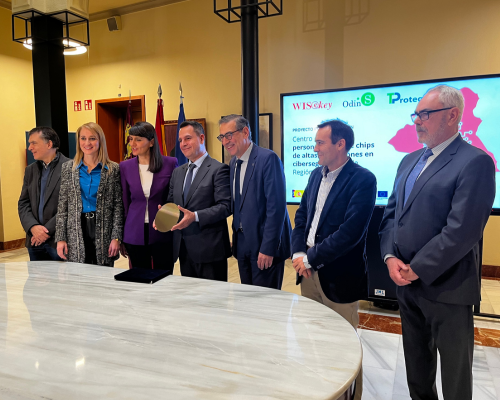The Ministry for Digital Transformation and Public Service is participating in Quantix Edge Security through the Spanish Society for Technological Transformation (SETT), along with the Murcia-based companies OdinS and TProtege, the Swiss company WiSeKey, and the French company SEALSQ.
June 17, 2025.- The Council of Ministers announced today, Tuesday, the launch of Quantix, an ambitious public-private joint venture , with a total investment of 40 million euros , made up of OdinS, a spin-off of the University of Murcia, the Murcian company TProtege, the Swiss company WISeKey and the French company SEALSQ, both listed on the NASDAQ, which will develop a Semiconductor Design and Customization Center in the Region of Murcia with advanced cybersecurity capabilities, post-quantum technology, AI and RISC-V systems.
The investment promoted by the Ministry for Digital Transformation and Public Service will exceed €19.6 million and will be managed through SETT (Spanish Society for Technological Transformation), a public company recently created by the Spanish Government to invest and participate in strategic and emerging companies and projects that drive Spain’s technological transformation.
This project, which began its public consolidation in February 2024, now culminates with the approval of financial support from the Spanish Government. Quantix represents a strategic public-private partnership of international scope and is aligned with the European Union’s digital transformation and technological sovereignty plans, responding to the challenge posed by cybersecurity in an ultra-connected world.
Quantix has projected 40 jobs in the first two years, 70 in the third year, and 152 in the fifth year, with the goal of reaching 250 employees by the eighth year of operation. It is promoting quality employment, research, and technology in the Region of Murcia with a plan to attract regional and international talent.
The creation of Quantix Edge Security will centralize part of the value chain in a single location in the Region of Murcia, reducing dependence on non-European suppliers in the design and manufacturing of microchips.
Due to cybersecurity regulations, which are being standardized by all national agencies, Quantix’s target market is focused on post-quantum resilient products , which, in 2030, will be critical for government applications such as passports, defense, as well as sensitive private environment applications.
This project has enjoyed the support of María González Veracruz from its inception in her various roles, both at the State Secretariat for Telecommunications and Digital Infrastructure and currently at the State Secretariat for Digitalization and Artificial Intelligence. She has repeatedly emphasized the importance of aligning this project with the financial instruments of the Strategic Project for the Economic Recovery and Transformation of Microelectronics and Semiconductors (PERTE Chip), promoted by the Spanish government.
The founder and CEO of OdinS and TProtege, José Trigueros , celebrates the launch of Quantix, an ambitious project that aims to position the region of Murcia as a European benchmark in innovation, microelectronics and technological sovereignty , positioning the region as a new international node for the development of secure microchips, leading the transition towards a resilient digital ecosystem that minimizes external dependencies in a changing geopolitical environment.
Carlos Moreira , Founder and CEO of WISeKey and SEALSQ “I would like to express my sincere congratulations to the Government of Spain and the Region of Murcia for this ambitious and strategic initiative that not only strengthens national capacity in cybersecurity, but also positions the region as a European benchmark in the development of key technologies such as post-quantum semiconductors.
“They both agree that the challenge ahead is enormous, but so is the positive impact we want to generate. We are going to create jobs, attract talent, develop cutting-edge technology, and place Murcia and Spain on the European map of semiconductors and cybersecurity.”
Collaborations with research centers, technology centers, and regional universities, especially the University of Murcia (UMU), which has extensive experience in cybersecurity and has participated in numerous security projects over the past twenty years, strengthen the scientific capacity of the proposed ecosystem.
SEALSQ and WISeKey have extensive international experience in cybersecurity and post-quantum semiconductor projects, developing advanced solutions for strategic sectors such as defense, healthcare, IoT, and aerospace. SEALSQ designs quantum-resistant microcontrollers and ASICs, integrating NIST-standard post-quantum algorithms such as Kyber, Dilithium, and Falcon, and collaborates with centers of excellence such as Mines Saint-Étienne in France. It is one of the few companies worldwide that produces semiconductors specifically designed to withstand quantum threats. Its technologies are present in more than 1.75 billion devices worldwide. WISeKey complements this capability with its global digital identity and PKI (Public Key Infrastructure) infrastructure, which includes post-quantum roots of trust, electronic voting systems, secure IoT devices, and certified blockchain platforms. Both companies have created a complete, sovereign digital security ecosystem capable of protecting critical infrastructures against emerging quantum threats, offering end-to-end solutions from chip to cloud, including authentication, encryption, identity, and data protection.
It is worth highlighting that OdinS, together with the companies WISeKey International Holding and SEALSQ, are involved in various international initiatives such as European (ETSI EN 303 645) and American (NIST IR 8425) regulations, which require manufacturers of connected objects to provide them with a digital identity , those relating to IoT lifecycle security management systems, as well as system security certification processes.
OdinS’s latest projects in RISC-V, SEALSQ’s projects in post-quantum chips, and WiSeKey’s projects in secure elements and roots of trust will leverage technological and commercial synergies, combining two decades of experience in IoT and cybersecurity.




